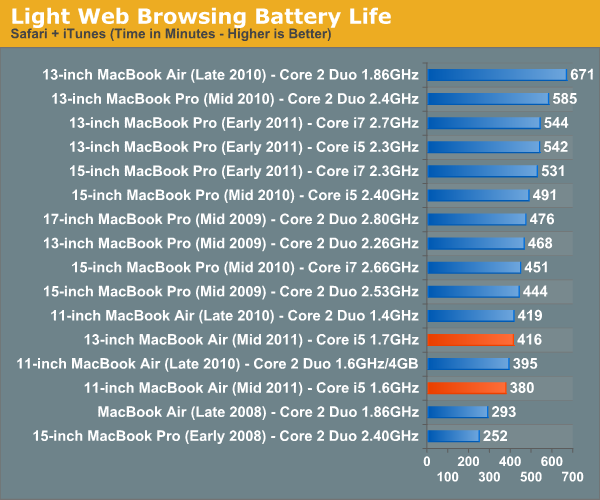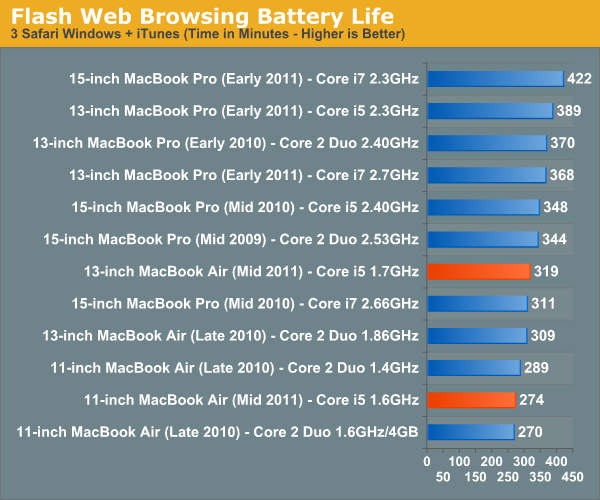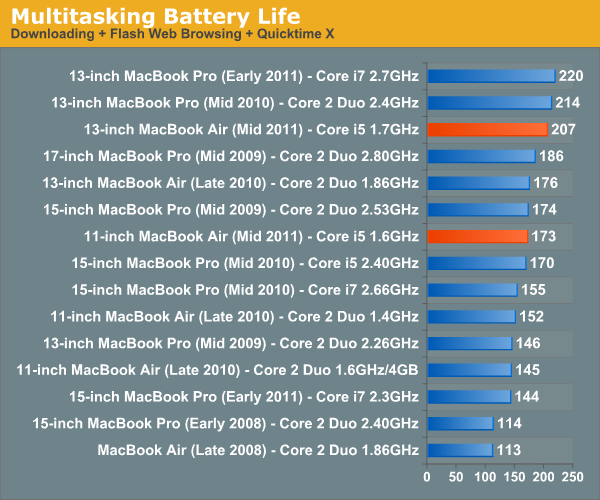The 2011 MacBook Air (11 & 13-inch): Thoroughly Reviewed
by Anand Lal Shimpi on July 28, 2011 3:25 AM EST- Posted in
- Apple
- Mac
- Intel
- Sandy Bridge
- MacBook Air
- Laptops
Battery Life
We've already established that the new MacBook Air lineup is significantly faster than its predecessor, but what does that do to battery life? Interestingly enough with a couple exceptions, not too much.
Let's look at the facts. Last year's MacBook Air used a 45nm Intel Core 2 Duo CPU paired with an NVIDIA chipset. The Core 2 is a very mature architecture that uses very little power under load. The 2011 Air gets the benefits of integration. The CPU and GPU are both on 32nm compared to 45/40nm for the previous generation. On top of that there's also power gating and architectural efficiencies to take into account.
The new Air models retain the same battery capacities as their predecessors: 35Wh for the 11 and 50Wh for the 13. It wasn't too long ago that the 15-inch MacBook Pro only had a 50Wh battery so this new 13-inch MacBook Air should be a good upgrade for users of older MacBook Pros even from a battery life standpoint.
Light Web Browsing
Here we're simply listening to MP3s in iTunes on repeat while browsing through a series of webpages with no flash on them. Each page forwards on to the next in the series after 20 seconds.
All screen savers are disabled, but the hard drive is allowed to go to sleep if there's no disk activity. The wireless connection is enabled and connected to a local access point less than 20 feet away. This test represents the longest battery life you can achieve on the platform while doing minimal work. The results here are comparable to what you'd see typing a document in TextEdit or reading documents.
Last year's 13-inch Air did amazingly well in our light web browsing battery life test, shattering even Apple's own expectations for the system. The new 13-inch MacBook Air doesn't fare as well.

While the new Air still delivers a respectable 6.9 hours of battery life in our lightest test, it's no where near what last year's model provided. If you're used to using your Air as a glorified typewriter, expect less battery life with the new model.
I'm not entirely sure why the 2010 13-inch MacBook Air did so well in our test. It lasted more than 60% longer than the 11-inch Air despite only having a 42% increase in battery capacity. There was something unique about that model that has since been lost.
The new 11 also loses out in the battery life department, but the drop isn't nearly as significant. The new 11 dies about 10% faster than last year's model in this test.
I should add that these results do generally support Apple's battery life claims for the MacBook Air. Apple lists the 13 as having up to 7 hours of battery life and the 11 with up to 5 hours.
Flash Web Browsing
The test here has three Safari windows open, each browsing a set of web pages with between 1—4 animated flash ads per page, at the same time. Each page forwards onto the next after about 20 seconds.
As always, the displays are set as close to one another as possible, audio at two bars, screensaver disabled and the hard drive is allowed to go to sleep if idle. The wireless connection is enabled and connected to a local access point less than 20 feet away.

Our light web browsing test is really the absolute best case scenario for battery life under OS X. I often use the term glorified typewriter because that's typically when you see these numbers: just typing away in a TextEdit window. For a writer, that's a valid usage model but for the majority of the population you'll be doing a bit more. This is where our Flash Web Browsing test comes in to play.
Here the numbers drop and the gap between last year's MBAs and the new systems shrinks to basically nothing. You can get around 5.3 hours of browsing duty out of the new 13 and a little over 4.5 hours from the new 11. Those numbers are near identical to last year's model, telling us that the increased power consumption of Sandy Bridge is almost entirely offset by better integration and the move to 32nm.
Multitasking Battery Life
Our final battery life test is the worst case scenario. In this test we have three open Safari windows, each browsing a set of web pages with between 1—4 flash ads per page, at the same time. We're also playing an XviD video in a window all while downloading files from a server at 500KB/s.

This test is really going to be the number a lot of power users see on a regular basis. Not giving the CPU much time to go to sleep results in very quick battery drain. Higher CPU demands also ensure that Sandy Bridge has room to flex its muscle, giving the new machines a bit of an advantage over last year's models. In a race to sleep, the faster CPU typically wins. If there's never any chance to sleep, the slower CPU usually lasts longer.
The new 13 does very well here, it's in the top 3 barely behind the 13-inch MBPs from last year and earlier this year. The 11 also puts forth a respectable effort, tying the 15-inch MacBook Pro from 2009/2010 and besting this year's model. Note that the 11 is significantly slower than the new 15-inch MacBook Pro, so while it'll last longer you may not be able to get as much done in the same amount of time. But compared to the rest of the systems in Apple's mobile lineup, the new Airs do relatively well under heavy load.
Looking at absolute numbers however the data is less impressive. The 13 is borderline acceptable with its 3.75 hours of battery life, while the 11 is a bit more disappointing at under 3.
The 11 vs. 13
If you're deciding on the 11 vs. 13, here's how the battery life breaks down between the two. On average you're going to gain another 38 minutes of usage with the 13-inch MacBook Air vs. the 11-inch model.
| OS X Battery Life Comparison | ||||||
| Light Web | Flash Web | Heavy Multitasking | Average | |||
| 13-inch MacBook Air | 416 minutes | 319 minutes | 207 minutes | - | ||
| 11-inch MacBook Air | 380 minutes | 274 minutes | 173 minutes | - | ||
| Advantage in Minutes | 36 minutes | 45 minutes | 34 minutes | 38 minutes | ||
| Advantage in Percent | 9.5% | 16.4% | 19.7% | 15.2% | ||
It looks like you'll see anywhere from an additional 10% to nearly 20% battery life from the 13. If we're talking time, the 13 will give you at least another half an hour of battery life from a full charge under OS X.










103 Comments
View All Comments
darwinosx - Saturday, July 30, 2011 - link
There is barely any difference between Elitebook models to talk about. Nor is there anything particularly special about them. Just another Windows clone made and supported a little better than what HP sells at Best Buy. Given that, it was covered quite well.OCedHrt - Thursday, July 28, 2011 - link
This is so last year. This is not even what I got in my Sony Z last year. For $1600. 2.4 ghz i5 (520m), GT 330M in 3 lb chasis with internal dvdrw. And that was bottom of the line. Not to mention I got mine from MSFT with 40% off.This year: http://store.sony.com/webapp/wcs/stores/servlet/Ca...
Of course this one costs way more, but still worth a though.
beginner99 - Thursday, July 28, 2011 - link
lol yeah. Sony is the only brand that has even more ridiculous pricing than Apple. You say it yourself 40% off. And in this case I say apple's pricing is very competitive and I'm an "apple-hater". Never owned a single device from them, not even an Ipod.The new base model Vaio Z will also be about 40% more expensive at half of the SSD capacity.
Anyway, I would have already bought it, if it was a windows system.
Johnmcl7 - Thursday, July 28, 2011 - link
I wouldn't say Sony's pricing is ridiculous as you're paying for absolutely cutting edge tech whereas with Apple . The previous Z series may have been pricey but it featured a 13.1 1080p screen (genuine 1920x1080), up to an i7 dual core processor, quad SSDs in RAID 0, dual graphics graphics cards (one integrated, one discrete), blu-ray writer which even Apple's 17in machines couldn't match but was smaller and lighter than Apple's 13in machines.I have the Vaio from the previous generation (Z5) which has a C2D 3Ghz processor, 13.1 1600x900 screen, dual 128GB mSSDs in RAID 0, blu-ray writer and integrated & discrete graphics cards which again Apple didn't offer anything even remotely comparable. Speccing up a Macbook to the maximum level put it far above the Vaio in cost but far below in spec with just a 2.6Ghz processor, DVD burner, single graphics card and low resolution screen.
John
darwinosx - Saturday, July 30, 2011 - link
Kids, read the review and learn something before commenting. No Sony has this proc in it yet. Also learn something about cpu speed in different processor models. Finally try to understand that this laptop is meant to be super thin and lightweight which the Sony is not. It is also top quality construction support and uses a modern OS.OCedHrt - Tuesday, August 2, 2011 - link
The sony from last year is nearly the same weight at 3.1 lb with an internal optical drive and the new one this year is much lighter at 2.5 lbs with external.The Sony Z specifically do not use ULV processors for maximum performance:
Intel® Core™ i5-2410M processor (2.30GHz) with Turbo Boost up to 2.90GHz
Intel® Core™ i5-2540M processor (2.60GHz) with Turbo Boost up to 3.30GHz
Intel® Core™ i7-2620M processor (2.70GHz) with Turbo Boost up to 3.40GHz
The base processor already matches the top of the line Air processor in turbo and far exceeds it in other conditions.
So to recap: Sony Z from last year (Z11-Z14) is already super thin and light weight at significantly faster performance for same cost, and sometimes cheaper when Microsoft Store has a crazy sale.
Sony Z for this year Z21 is even thinner and lighter at even faster performance for a slight premium. Remember the lowest Z performs better than the fastest Air. $1969 vs $1599 gives you an external dvdrw and discrete graphics and usb 3.0. That's not a bad deal at all.
Keep in mind the fastest Z will kill the Air in performance all in the same chasis. And battery life from reviews indicate the new Z is on-pair with Air (4+ hours with a movie playing continouously).
OCedHrt - Tuesday, August 2, 2011 - link
$1600 was not 40% off. I got mine for $1100. $1600 is the retail price at B&M for the entry level model that I outlined (with 64gb x2 SSD).ViRGE - Thursday, July 28, 2011 - link
Looking at the specs, something doesn't make sense. They're using 35W TDP processors and claiming better battery life on a smaller battery than the 13" MBA. The math doesn't add up on that one.KPOM - Thursday, July 28, 2011 - link
Might Sony be including the optional "sheet battery" in that time?ViRGE - Thursday, July 28, 2011 - link
Nope. They break that out separately.